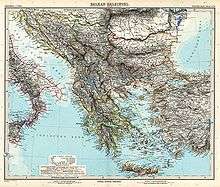University of Zagreb
| Sveučilište u Zagrebu | |
 | |
| Latin: Universitas Studiorum Zagrabiensis | |
| Type | Public |
|---|---|
| Established | 23 September 1669 |
| Endowment | 328.5 million HRK |
| Rector | Damir Boras |
Academic staff | 7,963 (2012)[1] |
| Students | 72,480 (2015)[2] |
| Postgraduates | 7243 (2007) |
| 842 (2007) | |
| Location | Zagreb, Croatia |
| Campus | City wide, central |
| Colours | |
| Affiliations | European University Association |
| Website | unizg.hr |
The University of Zagreb (Croatian: Sveučilište u Zagrebu, pronounced [sʋeǔt͡ʃiliːʃte u zǎːgrebu]; Latin: Universitas Studiorum Zagrabiensis) is the largest Croatian university and the oldest continuously operating university in the area covering Central Europe south of Vienna and all of Southeastern Europe.[3]
History of the University began on September 23, 1669, when the Holy Roman Emperor Leopold I issued a decree granting the establishment of the Jesuit Academy of the Royal Free City of Zagreb. Decree was accepted at the Council of the Croatian Kingdom on November 3, 1671. The Academy was run by the Jesuits for more than a century until the order was dissolved by Pope Clement XIV in 1773. In 1776 Empress Maria Theresa issued a decree founding the Royal Academy of Science which succeeded the previous Jesuit Academy. Bishop Josip Juraj Strossmayer proposed to the Croatian Parliament in 1861 founding of a University. Emperor Franz Joseph signed the decree on the establishment of the University of Zagreb in 1869. Act of Founding was passed by the Parliament in 1874, and was ratified by the Emperor on January 5, 1874. On October 19, 1874, a Royal University of Franz Joseph I was official opened.
University comprises 29 faculties, 3 art academies and 1 university center with more than 70.000 students. University is as of 2015 at a 551 place out of 1000 on the list of Universities of the world made by the Center for University World Rankings.[4]
History


Academy
The beginnings of the later university date back to 23 September 1669 when Emperor and King Leopold I Habsburg issued a decree granting the establishment of the Jesuit Academy of the Royal Free City of Zagreb.[5] According to that document the study of philosophy in Zagreb acquired a formal and legal status as Neoacademia Zagrabiensis and officially became a public institution of higher education.
The academy was run by the Jesuits for more than a century until the order was dissolved by Pope Clement XIV in 1773. Under a new leadership in 1772 the academy enrolled a total of 200 students.
In 1776 Empress and Queen Maria Theresa issued a decree founding the Royal Academy of Science (Latin: Regia Scientiarum Academia).[5] It consisted of three studies or faculties of philosophy, theology, and law. The former political-cameral studies became part of the newly established faculty of law, and thus were integrated into the academy. Each of the faculties of the Royal Academy of Sciences had several chairs teaching one or several courses.
The academy in Zagreb remained until 1874, despite numerous organizational changes, the focal institution of higher education in Croatia, educating most of the members of the Croatian intelligentsia.
University
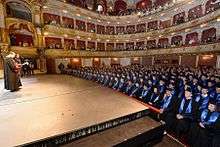
Bishop Josip Juraj Strossmayer in 1861 proposed to the Croatian Parliament the founding of a university at Zagreb. During his visit in 1869, the Emperor Franz Joseph signed the decree on the establishment of the University of Zagreb. Five years later, the Parliament passed the Act of Founding, which was ratified by the Emperor on 5 January 1874. On 19 October 1874, a ceremony was held in the name of the founding of the Royal University of Franz Joseph I in Zagreb,[6] making it the third university in the Hungarian realm of the Austro-Hungarian Empire.[7]
In 1874 the University had four faculties:
- Law (Pravno-državoslovni fakultet)
- Theology (Bogoslovni fakultet)
- Philosophy (Mudroslovni fakultet)
- Medicine (Liječnički fakultet)
The Faculty of Medicine was not put into function in 1874; it had to wait until 1917. The Faculty of Philosophy served as the general scientific faculty. Since 1876 it had geology, botany, physics, mathematics, and chemistry; since 1877 zoology; since 1882 pharmacy; since 1883 geography.
In 1860, the Royal Agriculture and Forestry College was founded in Križevci.[8] In 1898, the Academy of Forestry (Šumarska akademija) was founded as part of the Faculty of Philosophy, which encompassed all technical studies. In 1919, this school became the Faculty of Husbandry and Forestry.
In 1919, the School of Technology (Tehnička visoka škola) was founded, which was transformed into a university faculty in 1926. Also in 1919 the School of Veterinary Medicine (Veterinarska visoka škola) was founded; it transformed into a university faculty in 1925.
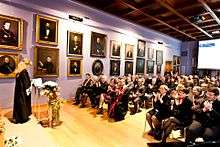
In the Faculty of Philosophy, major reorganization ensued in the 1920s, as mathematics, pharmacy and other sciences started to split off, first with the creation of separate mathematics and pharmaceutical departments in 1928, when the faculty was renamed into its current name Filozofski fakultet.
In 1926, the university was composed of seven faculties:
- Theology (Bogoslovni fakultet)
- Law (Pravnički fakultet)
- Medicine (Liječnički fakultet)
- Philosophy (Mudroslovni fakultet)
- Philosophy dept. (Filozofski odjel)
- Pharmacy dept. (Farmaceutski odjel)
- Husbandry and Forestry (Gospodarsko-šumarski fakultet)
- Veterinary Medicine (Veterinarski fakultet)
- Technology (Tehnički fakultet)
- Construction dept. (Građevni odsjek)
- Engineering dept. (Strojarski odsjek)
- Chemical engineering dept. (Kemijsko-inženjerski odsjek)
During the Independent State of Croatia (1941–1945), the university was known as the Croatian University (Hrvatsko sveučilište).
The individual departments of the Faculty of Philosophy became separate faculties in 1942, 1946 when the Faculty of Sciences was formed, and finally in 1963.
In 1956, the Faculty of Technology was divided into four faculties:
- Architecture-Construction-Geodesy (Arhitektonsko-građevinsko-geodetski fakultet)
- Electrical engineering (Elektrotehnički fakultet)
- Mechanical engineering-Shipbuilding (Strojarsko-brodograđevni fakultet)
- Chemistry-Food technology-Mining (Tehnološki fakultet)
These eventually split up into the current layout.
Faculties
- Faculty of Architecture
- Faculty of Chemical Engineering and Technology
- Faculty of Civil Engineering
- Faculty of Electrical Engineering and Computing
- Faculty of Geodesy
- Faculty of Geotechnics (in Varaždin)
- Faculty of Graphic Arts
- Faculty of Mechanical Engineering and Naval Architecture
- Faculty of Metallurgy (in Sisak)
- Faculty of Mining, Geology and Petroleum Engineering
- Faculty of Textile Technology
- Faculty of Transport and Traffic Sciences
- Faculty of Pharmacy and Biochemistry
- Faculty of Veterinary Medicine
- School of Dental Medicine
- School of Medicine
- Faculty of Agriculture
- Faculty of Food Technology and Biotechnology
- Faculty of Forestry
- Faculty of Economics and Business
- Faculty of Kinesiology
- Faculty of Law, University of Zagreb
- Faculty of Organization and Informatics in Varaždin
- Faculty of Political Science
- Faculty of Special Education and Rehabilitation
- Faculty of Teacher Education
- Catholic Faculty of Theology
- Faculty of Humanities and Social Sciences
- University Centre for Croatian Studies
Rectors
|
|
|
|
- Source: List of rectors at the University of Zagreb website
Legacy
Since 1874, more than 200,000 students have received a bachelor's degree, more than 18,000 a master's, and more than 8,000 a doctorate from the University of Zagreb.
Gallery


.jpg) Faculty of Mechanical Engineering and Naval Architecture
Faculty of Mechanical Engineering and Naval Architecture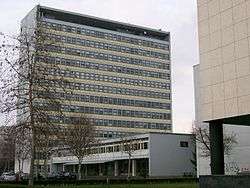

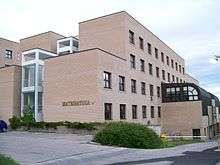
 Faculty of Textile Technology
Faculty of Textile Technology Faculty of Veterinary Medicine
Faculty of Veterinary Medicine- Faculty of Political Science
 Faculty of Forestry
Faculty of Forestry Faculty of Transport and Traffic Sciences
Faculty of Transport and Traffic Sciences Faculty of Special Education and Rehabilitation
Faculty of Special Education and Rehabilitation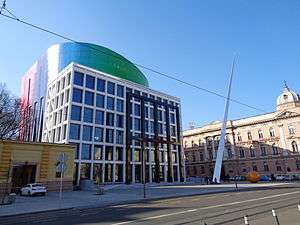
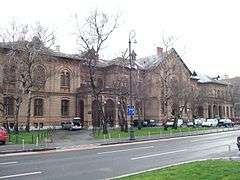
 Catholic Faculty of Theology
Catholic Faculty of Theology
See also
- Balkan Universities Network
- List of modern universities in Europe (1801–1945)
- List of universities in Croatia
- National and University Library Zagreb
References
- ↑ http://www.unizg.hr/fileadmin/rektorat/Studiji_studiranje/Studiji/Kvaliteta/Upravljanje_kvalitetom/Samoanliza_i_dokumentacija_za_vanjsku_neovisnu_prosudbu.pdf
- ↑ http://www.unizg.hr/homepage/
- ↑ Thomas, Liz; Wright, Malcolm (2011). Institutional Transformation to Engage a Diverse Student Body. Emerald Group Publishing. p. 236. ISBN 9780857249036.
- ↑ http://cwur.org/2015/University-of-Zagreb.html
- 1 2 Rüegg, Walter: "European Universities and Similar Institutions in Existence between 1812 and the End of 1944: A Chronological List", in: Rüegg, Walter (ed.): A History of the University in Europe. Vol. 3: Universities in the Nineteenth and Early Twentieth Centuries (1800–1945), Cambridge University Press, 2004, ISBN 978-0-521-36107-1, p. 685
- ↑ History of the University of Zagreb at public.carnet.hr
- ↑ Charle, Christophe: "Patterns", in Rüegg, Walter (ed.): A History of the University in Europe. Vol. 3: Universities in the Nineteenth and Early Twentieth Centuries (1800–1945), Cambridge University Press, 2004, ISBN 978-0-521-36107-1, p. 41
- ↑ Husinec, Renata, and Dejan Marenčić. n.d. "Križevci College of Agriculture." Accessed: April 13, 2013.
External links
Coordinates: 45°48′38.42″N 15°58′12.35″E / 45.8106722°N 15.9700972°E


